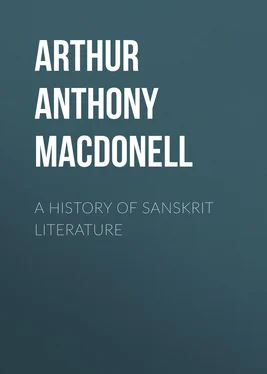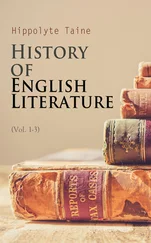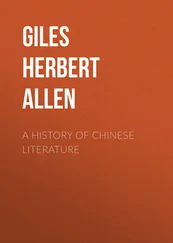Arthur Anthony MacDonell - A History of Sanskrit Literature
Здесь есть возможность читать онлайн «Arthur Anthony MacDonell - A History of Sanskrit Literature» — ознакомительный отрывок электронной книги совершенно бесплатно, а после прочтения отрывка купить полную версию. В некоторых случаях можно слушать аудио, скачать через торрент в формате fb2 и присутствует краткое содержание. Жанр: foreign_prose, foreign_antique, на английском языке. Описание произведения, (предисловие) а так же отзывы посетителей доступны на портале библиотеки ЛибКат.
- Название:A History of Sanskrit Literature
- Автор:
- Жанр:
- Год:неизвестен
- ISBN:нет данных
- Рейтинг книги:5 / 5. Голосов: 1
-
Избранное:Добавить в избранное
- Отзывы:
-
Ваша оценка:
- 100
- 1
- 2
- 3
- 4
- 5
A History of Sanskrit Literature: краткое содержание, описание и аннотация
Предлагаем к чтению аннотацию, описание, краткое содержание или предисловие (зависит от того, что написал сам автор книги «A History of Sanskrit Literature»). Если вы не нашли необходимую информацию о книге — напишите в комментариях, мы постараемся отыскать её.
A History of Sanskrit Literature — читать онлайн ознакомительный отрывок
Ниже представлен текст книги, разбитый по страницам. Система сохранения места последней прочитанной страницы, позволяет с удобством читать онлайн бесплатно книгу «A History of Sanskrit Literature», без необходимости каждый раз заново искать на чём Вы остановились. Поставьте закладку, и сможете в любой момент перейти на страницу, на которой закончили чтение.
Интервал:
Закладка:
The other division of the ritual Sūtras is based on smṛiti or tradition. These are the Gṛihya Sūtras , or “House Aphorisms,” which deal with the household ceremonies, or the rites to be performed with the domestic fire in daily life. As a rule, these rites are not performed by a priest, but by the householder himself in company with his wife. For this reason there is, apart from deviations in arrangement and expression, omission or addition, no essential difference between the various Gṛihya Sūtras, except that the verses to be repeated which they contain are taken from the Veda to which they belong. Each Gṛihya Sūtra, besides being attached to and referring to the Çrauta Sūtra of the same school, presupposes a knowledge of it. But though thus connected, the two do not form a unity.
The second class of Sūtras, which deal with social and legal usage, is, like the Gṛihya Sūtras, also based on smṛiti or tradition. These are the Dharma Sūtras , which are in general the oldest sources of Indian law. As is implied by the term dharma , “religion and morality,” their point of view is chiefly a religious one. They are closely connected with the Veda, which they quote, and which the later law-books regard as the first and highest source of dharma .
From the intensely crabbed and unintelligible nature of their style, and the studied baldness with which they present their subjects, it is evident that the Sūtras are inferior even to the Brāhmaṇas as literary productions. Judged, however, with regard to its matter, this strange phase of literature has considerable value. In all other ancient literatures knowledge of sacrificial rites can only be gained by collecting stray references. But in the ritual Sūtras we possess the ancient manuals which the priests used as the foundation of their sacrificial lore. Their statements are so systematic and detailed that it is possible to reconstruct from them various sacrifices without having seen them performed. They are thus of great importance for the history of religious institutions. But the Sūtras have a further value. For, as the life of the Hindu, more than that of any other nation, was, even in the Vedic age, surrounded with a network of religious forms, both in its daily course and in its more important divisions, the domestic ritual as well as the legal Sūtras are our most important sources for the study of the social conditions of ancient India. They are the oldest Indian records of all that is included under custom.
Besides these ritual and legal compendia, the Sūtra period produced several classes of works composed in this style, which, though not religious in character, had a religious origin. They arose from the study of the Vedas, which was prompted by the increasing difficulty of understanding the hymns, and of reciting them correctly, in consequence of the changes undergone by the language. Their chief object was to ensure the right recitation and interpretation of the sacred text. One of the most important classes of this ancillary literature comprises the Prātiçākhya Sūtras , which, dealing with accentuation, pronunciation, metre, and other matters, are chiefly concerned with the phonetic changes undergone by Vedic words when combined in a sentence. They contain a number of minute observations, such as have only been made over again by the phoneticians of the present day in Europe. A still more important branch of this subsidiary literature is grammar, in which the results attained by the Indians in the systematic analysis of language surpass those arrived at by any other nation. Little has been preserved of the earliest attempts in this direction, for all that had been previously done was superseded by the great Sūtra work of Pāṇini. Though belonging probably to the middle of the Sūtra period, Pāṇini must be regarded as the starting-point of the Sanskrit age, the literature of which is almost entirely dominated by the linguistic standard stereotyped by him.
In the Sūtra period also arose a class of works specially designed for preserving the text of the Vedas from loss or change. These are the Anukramaṇīs or “Indices,” which quote the first words of each hymn, its author, the deity celebrated in it, the number of verses it contains, and the metre in which it is composed. One of them states the total number of hymns, verses, words, and even syllables, contained in the Rigveda , besides supplying other details.
From this general survey of the Vedic period we now turn to a more detailed consideration of the different phases of the literature it produced.
Chapter III
The Rigveda
In the dim twilight preceding the dawn of Indian literature the historical imagination can perceive the forms of Aryan warriors, the first Western conquerors of Hindustan, issuing from those passes in the north-west through which the tide of invasion has in successive ages rolled to sweep over the plains of India. The earliest poetry of this invading race, whose language and culture ultimately overspread the whole continent, was composed while its tribes still occupied the territories on both sides of the Indus now known as Eastern Kabulistan and the Panjāb. That ancient poetry has come down to us in the form of a collection of hymns called the Rigveda . The cause which gathered the poems it contains into a single book was not practical, as in the case of the Sāma- and Yajur-veda , but scientific and historical. For its ancient editors were undoubtedly impelled by the motive of guarding this heritage of olden time from change and destruction. The number of hymns comprised in the Rigveda , in the only recension which has been preserved, that of the Çākala school, is 1017, or, if the eleven supplementary hymns (called Vālakhilya ) which are inserted in the middle of the eighth book are added, 1028. These hymns are grouped in ten books, called maṇḍalas , or “cycles,” which vary in length, except that the tenth contains the same number of hymns as the first. In bulk the hymns of the Rigveda equal, it has been calculated, the surviving poems of Homer.
The general character of the ten books is not identical in all cases. Six of them (ii.–vii.) are homogeneous. Each of these, in the first place, is the work of a different seer or his descendants according to the ancient tradition, which is borne out by internal evidence. They were doubtless long handed down separately in the families to which they owed their being. Moreover, the hymns contained in these “family books,” as they are usually called, are arranged on a uniform plan differing from that of the rest. The first, eighth, and tenth books are not the productions of a single family of seers respectively, but consist of a number of groups based on identity of authorship. The arrangement of the ninth book is in no way connected with its composers; its unity is due to all its hymns being addressed to the single deity Soma, while its groups depend on identity of metre. The family books also contain groups; but each of these is formed of hymns addressed to one and the same deity.
Turning to the principle on which the entire books of the Rigveda are arranged in relation to one another, we find that Books II.–VII., if allowance is made for later additions, form a series of collections which contain a successively increasing number of hymns. This fact, combined with the uniformity of these books in general character and internal arrangement, renders it probable that they formed the nucleus of the Rigveda , to which the remaining books were successively added. It further seems likely that the nine shorter collections, which form the second part of Book I., as being similarly based on identity of authorship, were subsequently combined and prefixed to the family books, which served as the model for their internal arrangement.
Читать дальшеИнтервал:
Закладка:
Похожие книги на «A History of Sanskrit Literature»
Представляем Вашему вниманию похожие книги на «A History of Sanskrit Literature» списком для выбора. Мы отобрали схожую по названию и смыслу литературу в надежде предоставить читателям больше вариантов отыскать новые, интересные, ещё непрочитанные произведения.
Обсуждение, отзывы о книге «A History of Sanskrit Literature» и просто собственные мнения читателей. Оставьте ваши комментарии, напишите, что Вы думаете о произведении, его смысле или главных героях. Укажите что конкретно понравилось, а что нет, и почему Вы так считаете.












